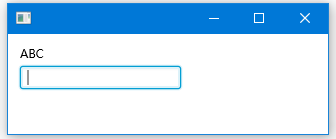JavaFX綁定
JavaFX綁定同步兩個值:當依賴變量更改時,其他變量更改。
要將屬性綁定到另一個屬性,請調用bind()方法,該方法在一個方向綁定值。 例如,當屬性A綁定到屬性B時,屬性B的更改將更新屬性A,但不可以反過來。
綁定選項
JavaFX提供了許多綁定選項,以便在域對象和GUI控件中的屬性之間進行同步。
我們可以在JavaFX的Properties API中使用以下三種綁定策略:
- Java Bean上的雙向綁定
- 與Fluent API的高級綁定
- 使用
javafx.beans.binding定義綁定對象進行低級綁定。
雙向綁定
雙向綁定綁定相同類型的屬性,並同步兩側的值。當使用bindBidirectional()方法雙向綁定時,需要兩個屬性都必須是可讀/寫的。
以下代碼顯示如何在firstName屬性和字符串屬性變量之間進行雙向綁定
import javafx.beans.property.SimpleStringProperty;
import javafx.beans.property.StringProperty;
public class Main {
public static void main(String[] args) {
User contact = new User("Jame", "Bind");
StringProperty fname = new SimpleStringProperty();
fname.bindBidirectional(contact.firstNameProperty());
contact.firstNameProperty().set("new value");
fname.set("新綁定名稱值");
System.out.println("firstNameProperty = " + contact.firstNameProperty().get());
System.out.println("fname = " + fname.get());
}// @ W WW .yI iB AI.c o M
}
class User {
private SimpleStringProperty firstName = new SimpleStringProperty();
private SimpleStringProperty lastName = new SimpleStringProperty();
public User(String fn, String ln) {
firstName.setValue(fn);
lastName.setValue(ln);
}
public final String getFirstName() {
return firstName.getValue();
}
public StringProperty firstNameProperty() {
return firstName;
}
public final void setFirstName(String firstName) {
this.firstName.setValue(firstName);
}
public final String getLastName() {
return lastName.getValue();
}
public StringProperty lastNameProperty() {
return lastName;
}
public final void setLastName(String lastName) {
this.lastName.setValue(lastName);
}
}上面的代碼生成以下結果。
firstNameProperty = 新綁定名稱值
fname = 新綁定名稱值高級別綁定
我們也可以使用JavaFX流利的API來綁定屬性。API使用類似英語的方法名稱對屬性執行操作。 例如,multiply(),divide(),subtract(),isEqualTo(),isNotEqualTo(),concat()。 請注意,方法名稱中沒有get或set。當鏈接API在一起時可以寫代碼,就像類似於寫英文句子,例如,width().multiply(height()).divide(2)。
以下代碼顯示如何創建表示計算矩形面積的公式的屬性。
它通過使用javafx.beans.binding.IntegerExpression接口中的fluent API來執行高級綁定。
該代碼使用multiply()方法,該方法返回包含計算值 - NumberBinding。
這個綁定是延遲評估求值的,這意味着乘法不會執行計算,除非通過get()或getValue()方法調用屬性的值。
import javafx.beans.binding.NumberBinding;
import javafx.beans.property.IntegerProperty;
import javafx.beans.property.SimpleIntegerProperty;
public class Main {
public static void main(String[] args) {
// Area = width * height
IntegerProperty width = new SimpleIntegerProperty(10);
IntegerProperty height = new SimpleIntegerProperty(10);
NumberBinding area = width.multiply(height);
System.out.println(area.getValue());
}
}上面的代碼生成以下結果。
100低級別綁定
當對NumberBinding類進行子類化時,使用低級別綁定,例如Double類型的DoubleBinding類。
在DoubleBinding類的子類中,我們覆蓋它的computeValue()方法,以便可以使用運算符(例如*和 - )來制定複雜的數學方程計算。
高級綁定使用如multiply(),subtract()等方法,而低級綁定使用諸如*和 - 等運算符。
以下代碼顯示如何爲公式創建低級別綁定,來計算矩形的面積。
import javafx.beans.binding.DoubleBinding;
import javafx.beans.property.DoubleProperty;
import javafx.beans.property.SimpleDoubleProperty;
public class Main {
public static void main(String[] args) {
DoubleProperty width = new SimpleDoubleProperty(2);
DoubleProperty height = new SimpleDoubleProperty(2);
DoubleBinding area = new DoubleBinding() {
{
super.bind(width, height); // initial bind
}
@Override
protected double computeValue() {
return width.get() * height.get();
}
};
System.out.println(area.get());
}
}上面的代碼生成以下結果。
4.0UI控件和域模型之間的綁定
在JavaFX中,UI控件和域模型之間的數據綁定很容易。以下代碼顯示如何創建登錄對話框並綁定用戶域對象。
首先,我們定義域對象,它是描述用戶名和密碼的JavaFX JavaBean。
class User {
private final ReadOnlyStringWrapper userName;
private StringProperty password;
public User() {
userName = new ReadOnlyStringWrapper(this, "userName", "ABC");
password = new SimpleStringProperty(this, "password", "");
}
public final String getUserName() {
return userName.get();
}
public ReadOnlyStringProperty userNameProperty() {
return userName.getReadOnlyProperty();
}
public final String getPassword() {
return password.get();
}
public StringProperty passwordProperty() {
return password;
}
}我們創建了兩個UI控件,一個用於使用Text控件顯示用戶名,另一個是 PasswordField 字段控件,它將輸入值綁定到域對象(User)中的 password 字段。
Text userName = new Text();
userName.textProperty().bind(user.userNameProperty());
PasswordField passwordField = new PasswordField();
passwordField.setPromptText("Password");
user.passwordProperty().bind(passwordField.textProperty());在更改偵聽器中爲passwordField字段文本值屬性設置BooleanProperty訪問權限。
passwordField.textProperty().addListener((obs, ov, nv) -> {
boolean granted = passwordField.getText().equals(MY_PASS);
accessGranted.set(granted);
if (granted) {
primaryStage.setTitle("");
}
});在enter鍵點擊事件中訪問BooleanProperty accessGranted。
// user hits the enter key
passwordField.setOnAction(actionEvent -> {
if (accessGranted.get()) {
System.out.println("granted access:"+ user.getUserName());
System.out.println("password:"+ user.getPassword());
Platform.exit();
} else {
primaryStage.setTitle("no access");
}
});完整的源代碼如下所示。
import javafx.application.Application;
import javafx.application.Platform;
import javafx.beans.property.BooleanProperty;
import javafx.beans.property.ReadOnlyStringProperty;
import javafx.beans.property.ReadOnlyStringWrapper;
import javafx.beans.property.SimpleBooleanProperty;
import javafx.beans.property.SimpleStringProperty;
import javafx.beans.property.StringProperty;
import javafx.scene.Group;
import javafx.scene.Scene;
import javafx.scene.control.PasswordField;
import javafx.scene.layout.VBox;
import javafx.scene.text.Text;
import javafx.stage.Stage;
// @ w Ww .yi iB A i. C o M
public class Main extends Application {
private final static String MY_PASS = "passwd";// 初始密碼
private final static BooleanProperty accessGranted = new SimpleBooleanProperty(false);
@Override
public void start(Stage primaryStage) {
User user = new User();
Group root = new Group();
Scene scene = new Scene(root, 320, 100);
primaryStage.setScene(scene);
Text userName = new Text();
userName.textProperty().bind(user.userNameProperty());
PasswordField passwordField = new PasswordField();
passwordField.setPromptText("Password");
user.passwordProperty().bind(passwordField.textProperty());
// user hits the enter key
passwordField.setOnAction(actionEvent -> {
if (accessGranted.get()) {
System.out.println("granted access:" + user.getUserName());
System.out.println("password:" + user.getPassword());
Platform.exit();
} else {// @ WW w .yIIB A i.c OM
primaryStage.setTitle("no access");
}
});
passwordField.textProperty().addListener((obs, ov, nv) -> {
boolean granted = passwordField.getText().equals(MY_PASS);
accessGranted.set(granted);
if (granted) {
primaryStage.setTitle("");
}
});
VBox formLayout = new VBox(4);
formLayout.getChildren().addAll(userName, passwordField);
formLayout.setLayoutX(12);
formLayout.setLayoutY(12);
root.getChildren().addAll(formLayout);
primaryStage.show();
}
public static void main(String[] args) {
launch(args);
}
}
class User {
private final ReadOnlyStringWrapper userName;
private StringProperty password;
public User() {
userName = new ReadOnlyStringWrapper(this, "userName", "ABC");
password = new SimpleStringProperty(this, "password", "");
}
public final String getUserName() {
return userName.get();
}
public ReadOnlyStringProperty userNameProperty() {
return userName.getReadOnlyProperty();
}
public final String getPassword() {
return password.get();
}
public StringProperty passwordProperty() {
return password;
}
}上面的代碼生成以下結果。

在上面的輸入框中輸入密碼:passwd 完成後,得到以下輸出結果 -
granted access:ABC
password:passwd